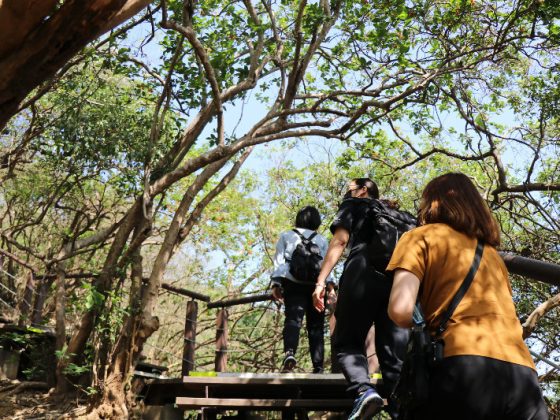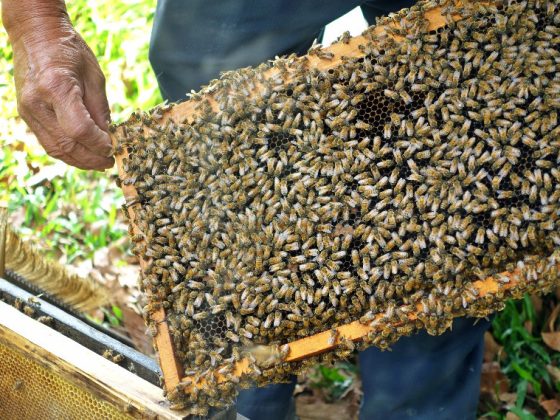Around the world, summer is the time for fun in the sun. It’s a time when people emerge from winter hibernation to thaw out their stiff bodies and work on their tan. Taipei City boasts a diverse range of green spaces, world-class hiking trails, and riverside parks, making it a remarkable place to call home and a hospitable destination to visit. However, the relentless summer humidity can seem overwhelming at times, forcing the unaccustomed to seek refuge indoors. If you are one of those who are after some refreshing alternatives, we have five cool outdoor places for you to chill out this summer. Ranging from peaceful jaunts to historic mountain trails to fun for all ages at the downtown waterparks, our list caters to the whole family.
Let’s dive in.
***Please be sure to observe weather and water conditions and exercise caution when entering any body of water, and always closely supervise children.***
Hushan Hiking Trail 虎山親山步道
First on our list is Hushan Hiking Trail, concealed within the forest bordering the illustrious Xinyi District in central Taipei. Hushan, or Tiger Mountain, is home to one of the Sihshoushan (四獸山, Four Beasts Mountains) Circular Hiking Trails, an expansive network of trails crisscrossing the southern reaches of the Taipei Basin. This means there are numerous trailheads to enter and many paths to walk. This labyrinth of tracks runs throughout the peaks and valleys of the four beasts mountains, so named for the animals they are said to resemble: Xiangshan (象山, Elephant Mountain), Shishan (獅山, Lion Mountain), Baoshan (豹山, Leopard Mountain) and Hushan (虎山, Tiger Mountain). (Read more: An Afternoon at Elephant Mountain)
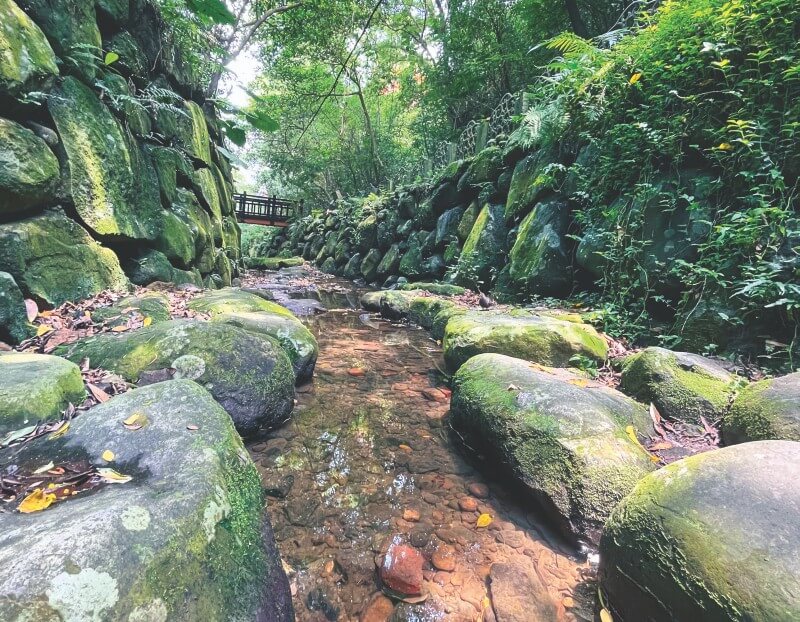
The primary entrance to Hushan is tucked away behind Songshan Tsu Huei Temple (松山慈惠堂). It’s located approximately 15 minutes on foot south of MRT Houshanpi Station (捷運後山埤站) on the Bannan Line (板南線, Blue Line), or there are buses running along nearby Fude Street (福德街) that can get you near the trailhead. From the very beginning, the trail splits into two, so you can walk a full circuit if you like. Take note that there is one path to the left that goes up the stairs beside the temple and one to the right that will follow Hushan Creek (虎山溪), which comes into view within three minutes of entering the trail. The stream flows beside the path, attracting dragonflies, birds, and more small creatures. Stairs at the first stone bridge allow visitors to go down to the creek and dip their feet into the cool water. If you walk across the bridge and follow the trail for another minute, a flat square by the stream offers a safer option for hikers with young children as the depth of water is more kid-friendly.
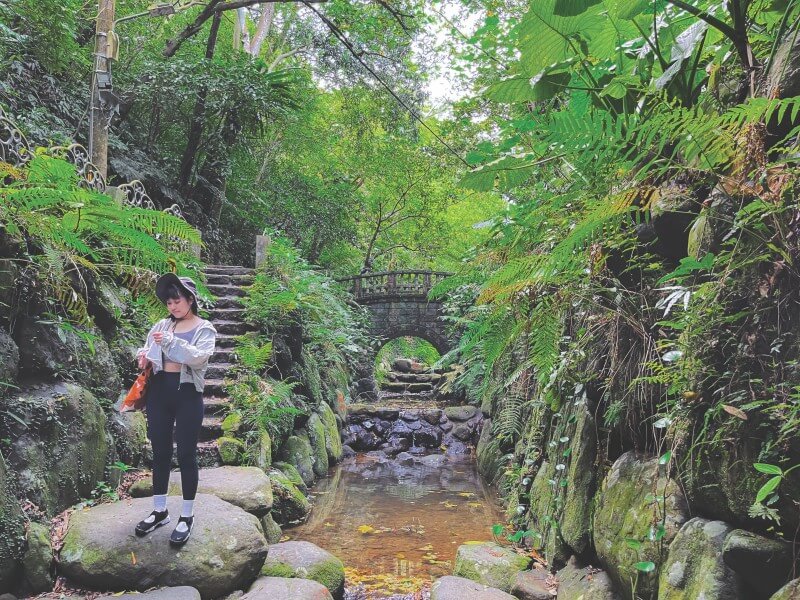
In terms of hiking difficulty, Hushan is rather mild compared to the steeper ascents of the nearby Jiuwu Peak (九五峰) and Xiangshan trails. It’s a gradual climb up the stone path beneath a canopy of tropical foliage, and the creek offers respite from the ambient heat of the concrete jungle.
Pingding Ancient Canal Hiking Trail 坪頂古圳步道
Next up is the Pingding Ancient Canal Hiking Trail, sheltered within the foothills of the mighty Yangmingshan (陽明山, Mt. Yangming) in the Shilin District. The closest trailhead to the city is about seven kilometers from the National Palace Museum (國立故宮博物院), and is accessible by bus from MRT Jiantan Station (捷運劍潭站). (You might also like: The Ultimate Hiking Guide to Yangmingshan National Park)
The highlight of this trail is the series of canals — Pingding Ancient Canal (坪頂古圳), New Pingding Canal (坪頂新圳), and Dengfeng Canal (登峰圳) — which were carved into the mountainside by local residents for farming and domestic water usage during the Qing Dynasty (清朝, 1636 A.D. – 1912 A.D.). Pingding Ancient Canal, the oldest of the three, was constructed in 1834 and still provides fresh water, along with the other two canals, to the surrounding area. They capture clean mountain water from many small waterfalls and the runoff seeping out of the earth. Other than providing precious water to us, the area is home to many native animals. Small fish, frogs, and lizards can be spotted with a keen eye.
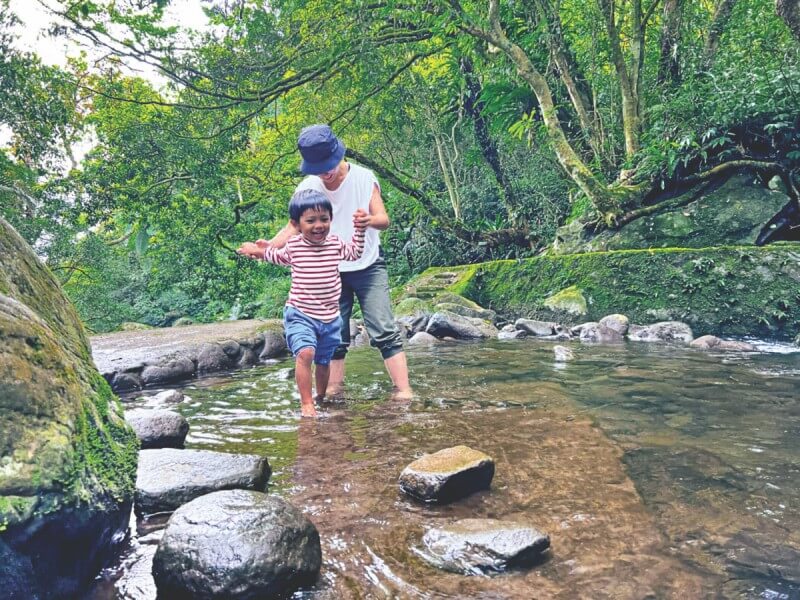
The main trail circuit is 2.3 kilometers long, and gently winds through the lush, green valley and crosses all three canals and Neishuangxi (內雙溪). Shielded by the thick canopy, it is a refreshing spot to wade in the crisp mountain stream. The smooth boulders by the creek are a prime location to sit down, meditate and absorb the ambiance of the forest. All in all, it is a rare blend of human history and the unadulterated beauty of Mother Nature.

Dagouxi Ecology and Water-Control Park 大溝溪生態治水園區
Third on our list is Dagouxi Ecology and Water-Control Park. It is situated in the Neihu District in northeastern Taipei. To reach the park, you can walk about 850 meters along Dahushanzhuang Street (大湖山莊街) from MRT Dahu Park Station (捷運大湖公園站).
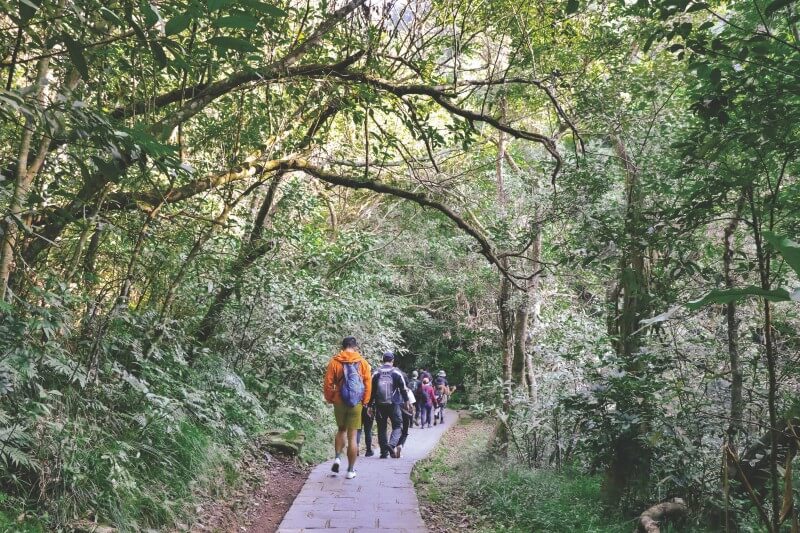
The park boasts sweeping grassy fields abutted by gentle hills; perfect for parents to let their kids or dogs run free. The quaint stone path meanders through the small wetland as it traces the stream up the valley. Once you duck under the cover of the canopy, the remaining walk is cool and well-shaded.
There are plenty of places to rest along the way, but the prime destination is Yuanjue Waterfall (圓覺瀑布), about a 20-minute walk from the trailhead. It has lots of seating available to enjoy a picnic and waterfall views. You can also dip your feet into the water if the mood takes you.
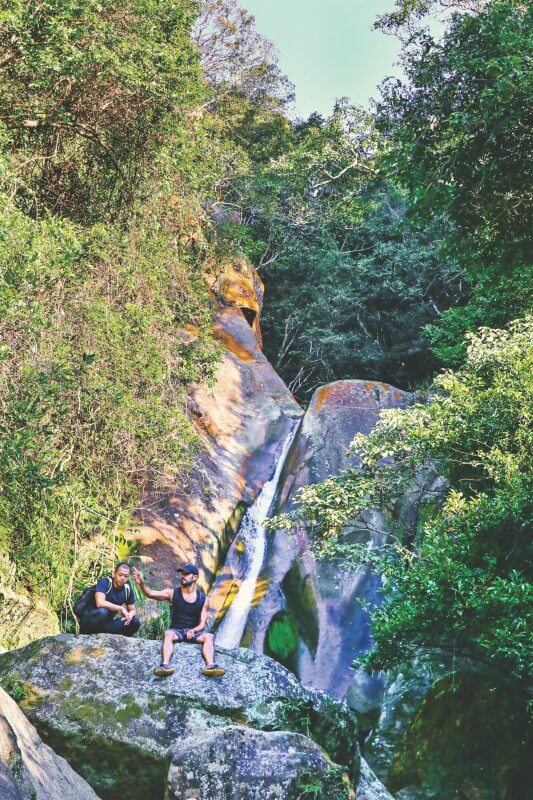
This trail is also part of Section 4 of the Taipei Grand Trail (台北大縱走), a network of mountain trails that span across Taipei for 92 kilometers. So, if you continue climbing you will reach Bishan Temple (碧山巖) and can journey further on to Jinmianshan (金面山, Mt. Jinmian) or even all the way to Yangmingshan. If you decide to have a chill afternoon instead, just stay in Dagouxi Ecology and Water-Control Park. It has one of the most easily accessible waterfall trails in Taipei, and is perfect for a summer day trip. (Read also: Taipei’s Organic Agriculture Mountain Tourist – Farm Experience in the Baishihu Area)
Taipei Water Park 台北自來水園區
If you want to amp up the thrills, then head to number four on our list, Taipei Water Park in the Zhongzheng District in southern Taipei. It’s within walking distance of MRT Gongguan Station (捷運公館站) on the Songshan-Xindian Line (松山新店線, Green Line).
One of the highlights in the park for outdoor fun in the summer is the Xiaoguanyin Shan Ecological Hiking Trail (小觀音山生態登山步道). It is a shady trail hidden in the back of the park, leading hikers to one of the oldest reservoirs in Taipei — Guanyinshan Reservoir (觀音山蓄水池). This century-old reservoir is the most important source of tap water in Taipei, and it compares favorably with other international underground palaces. Entering the cistern walkway (reservation required), you can not only keep cool in the summer heat, but also travel through time and space. If the summer sunshine is too hot to handle, you can also hide inside the Museum of Drinking Water (自來水博物館), where the development of Taipei’s water supply system is displayed within the confines of exquisite Baroque architecture.
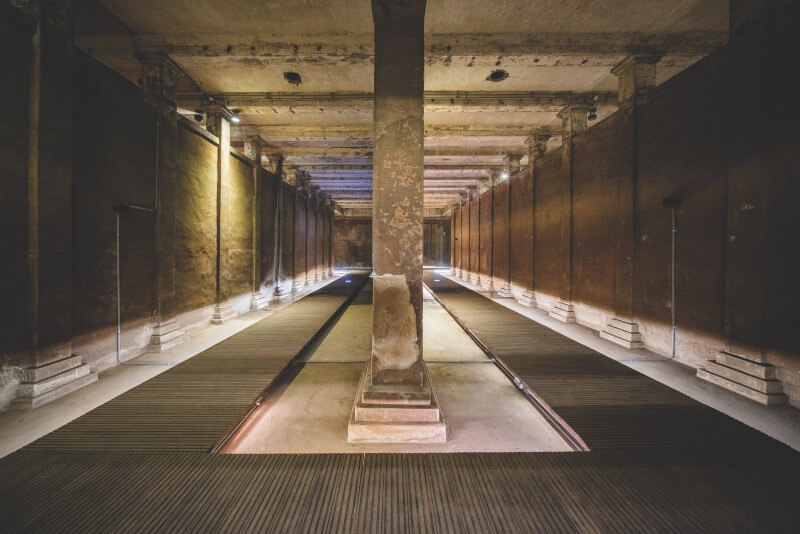
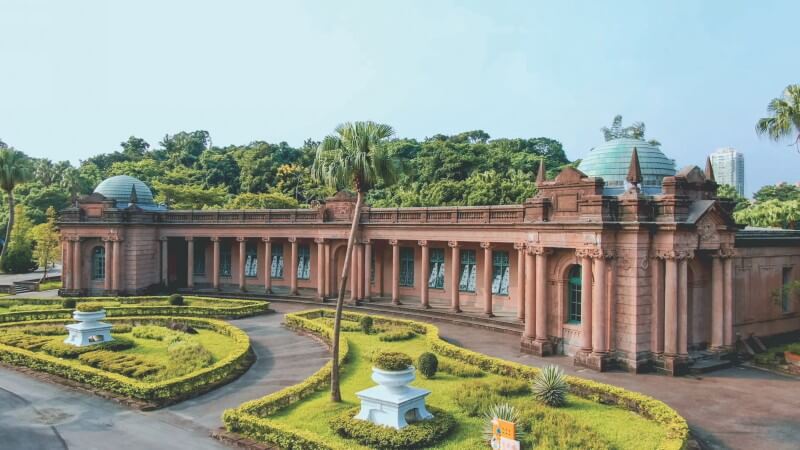
During these vacation months, Taipei Riverside Children’s Fun Carnival (台北河岸童樂會) is held by the Taipei City Government at the Taipei Water Park from August 19th to 28th. The carnival brings in more inflatable water slides and pools to the park, allowing kids to have great fun under the sun. Please note that full admission is NT$80, and for children under 12 and students the price is NT$40. (Read more: Taipei Summer Hotspots: Beat the Heat This Summer with These Five Family-Friendly Outdoor Destinations)
Dajia Riverside Park
Last but not least on our list is Dajia Riverside Park on the banks of the Keelung River (基隆河), at the northern edge of central Taipei’s Zhongshan District and close to Taipei Songshan Airport (台北松山機場). The best way to access the park is to take the bus or ride a bike. (Read more: Blue Ribbons: A Riverside Guide to Taipei)
Taipei is wedged between the Keelung and Tamsui Rivers (淡水河). There are several bike paths within its bounds, with the shortest about eight kilometers and the longest coming in at 47 kilometers, and many playgrounds, exercise facilities and parklands to discover just outside the city’s floodgates. An expansive park stretching west from the Dazhi Bridge (大直橋) — Dajia Riverside Park is connected to all the riverside parks that wrap around Taipei. Because of the interminable bike paths, cycling here is a fantastic way to view Taipei from another vantage point. It’s a vast and dynamic playground with plenty of space to play.
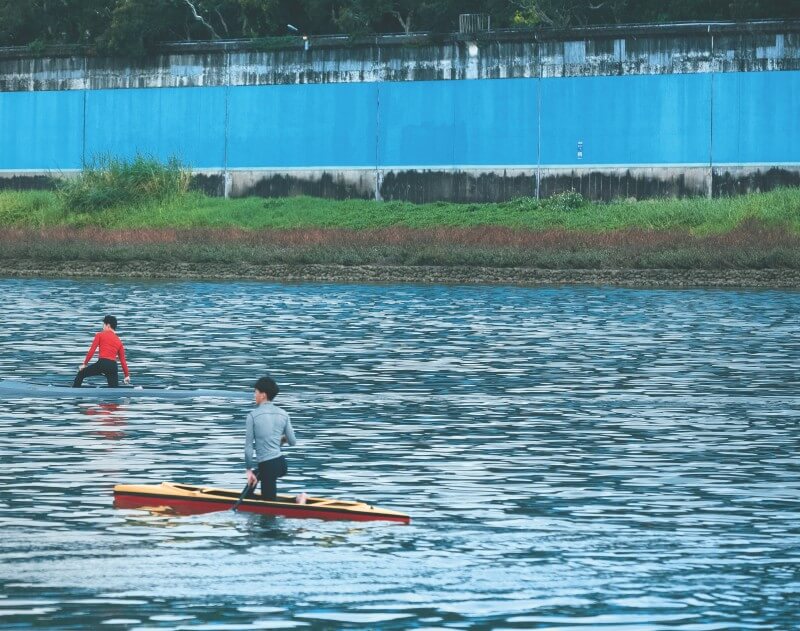
The highlight of this section of Dajia Riverside Park is the Fountain of Hope (希望之泉). Sitting on the west side of the long and narrow park, the fountain spouts once every hour from 10 a.m. to 5 p.m., producing water jets that are over 70 meters high. From July to August, extra shows with splendid illumination effects will take place twice nightly at 7:00 p.m. and 8:00 p.m. With each session lasting 15 minutes, visitors can watch the amazing show by the river while enjoying the instagrammable background view of The Grand Hotel (圓山大飯店). In addition to the fountain, there is also regular play equipment like slides and swings. The shaded sandpits have diggers, too, so remember to bring your buckets and spades to build some sandcastles.
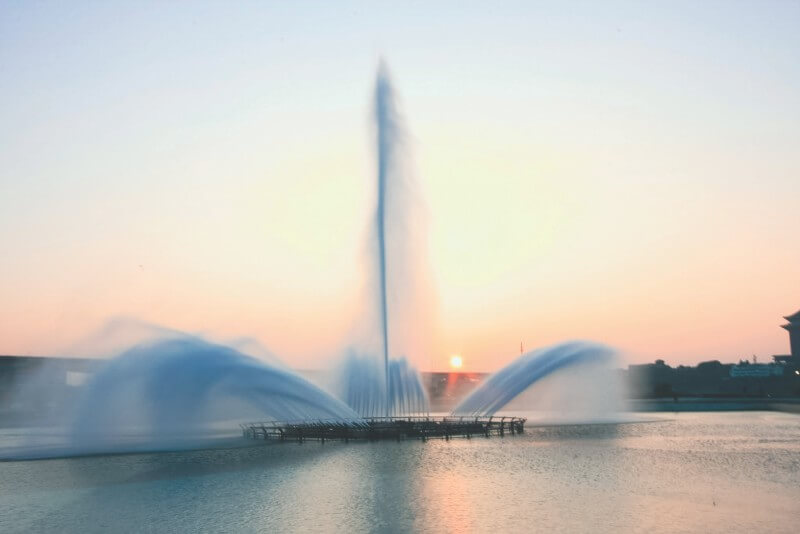
Author Nathan Ray
Photographer Taiwan Scene, Taipei Water Park, Samil Kuo, Hydraulic Engineering Office, Taipei City Government
This article is reproduced under the permission of TAIPEI. Original content can be found on the website of Taipei Travel Net (www.travel.taipei/en).


